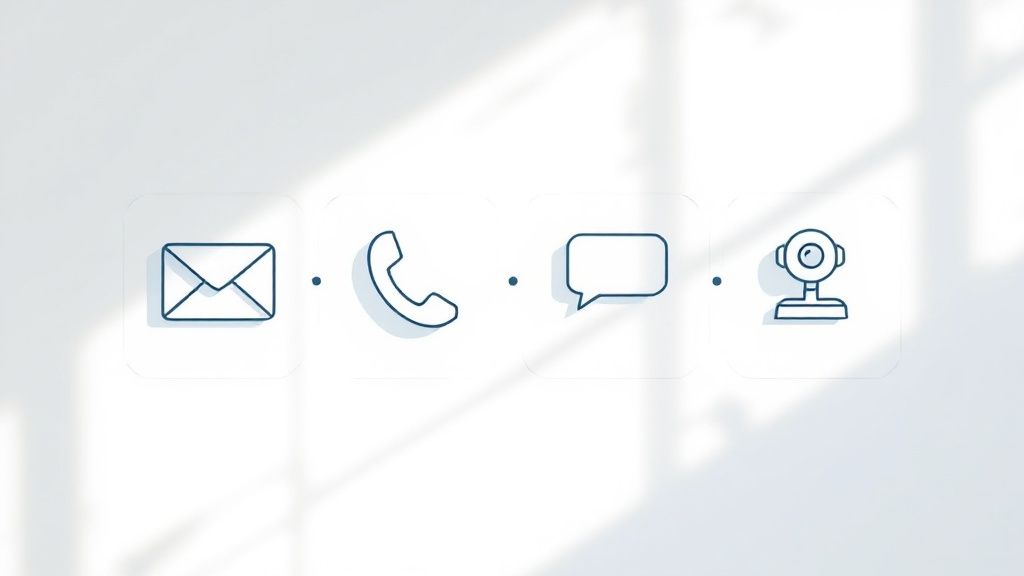
In the fast-paced world of agencies, creators, and freelancers, the quality of your work is only half the battle. The other half? Mastering client communication. Misaligned expectations, missed deadlines, and endless revisions often stem from communication breakdowns, not a lack of talent. This common pain point can derail projects, strain professional relationships, and ultimately impact your bottom line. But what if you could transform communication from a potential pitfall into your greatest competitive advantage? This guide unpacks eight proven client communication best practices designed to build unbreakable trust, streamline workflows, and ensure every project is a resounding success. By implementing these strategies, you can create true partnerships that foster growth and long-term loyalty.
1. Active Listening and Empathetic Communication
One of the most foundational client communication best practices is shifting from passive hearing to active listening. This means fully concentrating on what the client is saying, understanding the context and emotion behind their words, and responding thoughtfully. For an agency, this could mean recognizing a client's hesitation about a proposed campaign isn't about budget, but about fear of brand risk. For a freelancer, it might be hearing that a request for a "small change" is really a sign of deeper strategic uncertainty. This approach builds a strong foundation of trust and rapport, making the client feel genuinely heard and valued. When clients believe you truly understand their problems, they become more collaborative and transparent. A cornerstone of effective client communication is mastering empathy in customer service to build stronger connections.

How to Implement Active Listening:
- Eliminate Distractions: During client calls, close unnecessary tabs and give the conversation your full attention. This simple act shows respect for the client's time.
- Paraphrase and Clarify: Periodically summarize what you've heard. Use phrases like, "So, what I'm hearing is that the main bottleneck is..." to ensure alignment.
- Ask Open-Ended Questions: Instead of "Do you like this design?", ask "What are your initial thoughts on how this design addresses our campaign goals?"
- Listen to What Isn't Said: Pay attention to tone of voice and hesitation. These cues often reveal underlying concerns that aren't explicitly stated.
2. Establish Clear Communication Channels
Ambiguity is the enemy of effective client relationships. Establishing clear communication channels eliminates confusion and ensures clients know exactly how, when, and where to reach you. This involves proactively defining the right tools for different interactions—from urgent requests to routine updates—and setting clear expectations about response times. A real-world example for a marketing agency would be: Slack for quick, daily check-ins; a project management tool like Asana for task-specific feedback; email for formal approvals and weekly summaries; and phone calls reserved for urgent issues. When clients don't have to guess, their confidence in your process grows, preventing minor issues from escalating. This consistency is also the backbone of successful integrated advertising campaigns.

How to Implement Clear Channels:
- Define Channels by Urgency: Use a project management tool for daily updates, email for formal documentation, and a dedicated phone number for true emergencies.
- Create a Communication Plan: At project kickoff, provide clients with a simple document outlining all channels, their purpose, your business hours, and expected response times.
- Leverage a Centralized Platform: Use a tool like Asana or Trello to keep all client-related communication in one place, ensuring any team member can quickly get up to speed.
- Use Auto-Responders Wisely: Set up automated email replies to acknowledge receipt of a query. This confirms their message was received and manages expectations effectively.
3. Provide Regular, Proactive Updates
Effective client communication shifts from being reactive to proactive. Instead of waiting for a client to ask for an update, this practice involves reaching out with regular, meaningful information about project progress, upcoming milestones, and potential roadblocks. For a content creator managing a client's social media, this could be a brief weekly email with key performance metrics and a preview of the upcoming week's posts. This approach keeps clients informed and confident, preventing the anxiety that arises from silence. By anticipating their need for information, you build significant trust and drastically reduce the number of "just checking in" emails, freeing up time for both parties to focus on strategic work.

How to Implement Proactive Updates:
- Establish a Cadence: At the start of a project, agree on a communication schedule. Ask if they prefer a weekly status report, a bi-weekly call, or a monthly performance dashboard.
- Create Clear Templates: Develop standardized templates for your updates to ensure consistency. Include what was accomplished, what's next, and any outstanding questions.
- Leverage Automation: Use project management tools to set reminders for scheduled check-ins. Exploring marketing automation best practices can also help streamline the delivery of performance reports.
- Be Honest and Transparent: Proactive updates are not just for good news. If a challenge arises, communicate it early along with a proposed solution. This transparency builds far more trust than hiding a problem.
4. Set and Manage Clear Expectations
One of the most significant sources of client friction is a mismatch between expectations and reality. Setting and managing clear expectations involves defining the project scope, timelines, deliverables, and communication boundaries from the very beginning. This foundational practice prevents misunderstandings, scope creep, and disappointment, ensuring both parties are aligned on what success looks like. For a startup engaging a marketing agency, this means documenting not just the number of blog posts to be delivered, but also the review process, the number of revision rounds included, and the expected turnaround time for feedback. When expectations are documented and agreed upon, they serve as a North Star for the engagement, guiding decisions and establishing a framework for accountability.

How to Implement Expectation Management:
- Document Everything in Writing: Formalize all key agreements in a detailed Statement of Work (SOW) or project brief. This should explicitly outline deliverables, timelines, costs, and responsibilities.
- Establish Clear Boundaries: Define your communication protocols upfront, specifying your working hours, preferred contact methods, and expected response times.
- Create a Formal Change Order Process: Institute a clear process for handling requests that fall outside the original agreement, detailing how new requests are evaluated, quoted, and integrated.
- Review and Realign Regularly: Use check-ins to review progress against the initial plan and realign expectations if project variables or priorities have shifted.
👉 Try MediaWorkbench.ai for free – schedule your posts and generate AI content in one place!
5. Personalize Your Communication
Moving beyond generic templates is a hallmark of exceptional client service. Personalized communication involves adapting your style, content, and medium to match each client's unique preferences, industry, and personality. This practice acknowledges that a one-size-fits-all approach is far less effective than targeted messaging. For instance, a data-driven marketing director at a tech startup will appreciate concise, bullet-pointed emails with clear metrics, while a solo creator in the wellness space might prefer a more conversational, collaborative tone over a video call. When clients see that you understand their world and respect their preferences, they feel valued, which strengthens the partnership. For a deep dive into leveraging email for highly customized interactions, refer to an ultimate guide to personalized email success.
6. Handle Problems with Transparency
No project is immune to challenges. One of the most critical client communication best practices is how you handle issues when they arise. Transparent problem resolution involves openly acknowledging problems, communicating honestly about the path to a solution, and taking ownership rather than assigning blame. Imagine a social media campaign for a client underperforms. Instead of avoiding the topic, a proactive marketer would schedule a call to say, "The initial results for this campaign are not meeting our benchmarks. Here's our analysis of what happened, and here are three adjustments we recommend testing immediately." This transparent, proactive approach can transform a potential disaster into a moment that reinforces your integrity and reliability, strengthening the client relationship through adversity.
7. Master Documentation and Follow-Up
One of the most crucial client communication best practices is establishing a system for meticulous documentation and consistent follow-up. This means creating a clear, accessible record of all client interactions, decisions, and action items. For a busy agency, this prevents critical feedback from getting lost in a long email thread. After any significant client call, sending a concise summary email outlining key discussion points, decisions made, and a clear list of action items with assigned owners and deadlines is non-negotiable. This systematic approach transforms potential chaos into organized clarity, ensuring promises made are promises kept and reinforcing client trust at every stage.
8. Provide Value Beyond the Deliverables
Exceptional client communication transcends project updates. It evolves into a practice of providing consistent value that extends beyond the immediate scope of work. This positions you as a trusted advisor, not just a service provider. For a content marketing agency, this could mean sending a client a link to a new industry report with a note: "Saw this report on emerging consumer trends in your sector and thought of your Q4 planning." This proactive sharing of insights, trends, and knowledge benefits the client's broader business goals and cements your role as an indispensable resource. Understanding the fundamentals of a content marketing strategy is crucial for making this effort effective and scalable.
Conclusion
Mastering client communication is about shifting from a service provider to a strategic partner. The eight best practices we've explored—from active listening to providing value-driven insights—are the building blocks of this transformation. By setting clear expectations, you prevent misunderstandings. By providing proactive updates, you build confidence. And by handling challenges with transparency, you forge unbreakable trust. Implementing these client communication best practices directly impacts your bottom line by reducing scope creep, minimizing costly revisions, and turning satisfied clients into your best source of referrals. Don't try to overhaul everything at once. Start by picking one or two practices to focus on, systematize your process, and build from there.
Ready to streamline your client workflows and communication? MediaWorkbench.ai provides a unified platform to generate polished reports, schedule automated updates, and manage content creation in one place. Deliver a seamless, professional experience every time. Explore Media Workbench AI today and turn best practices into your daily reality.

